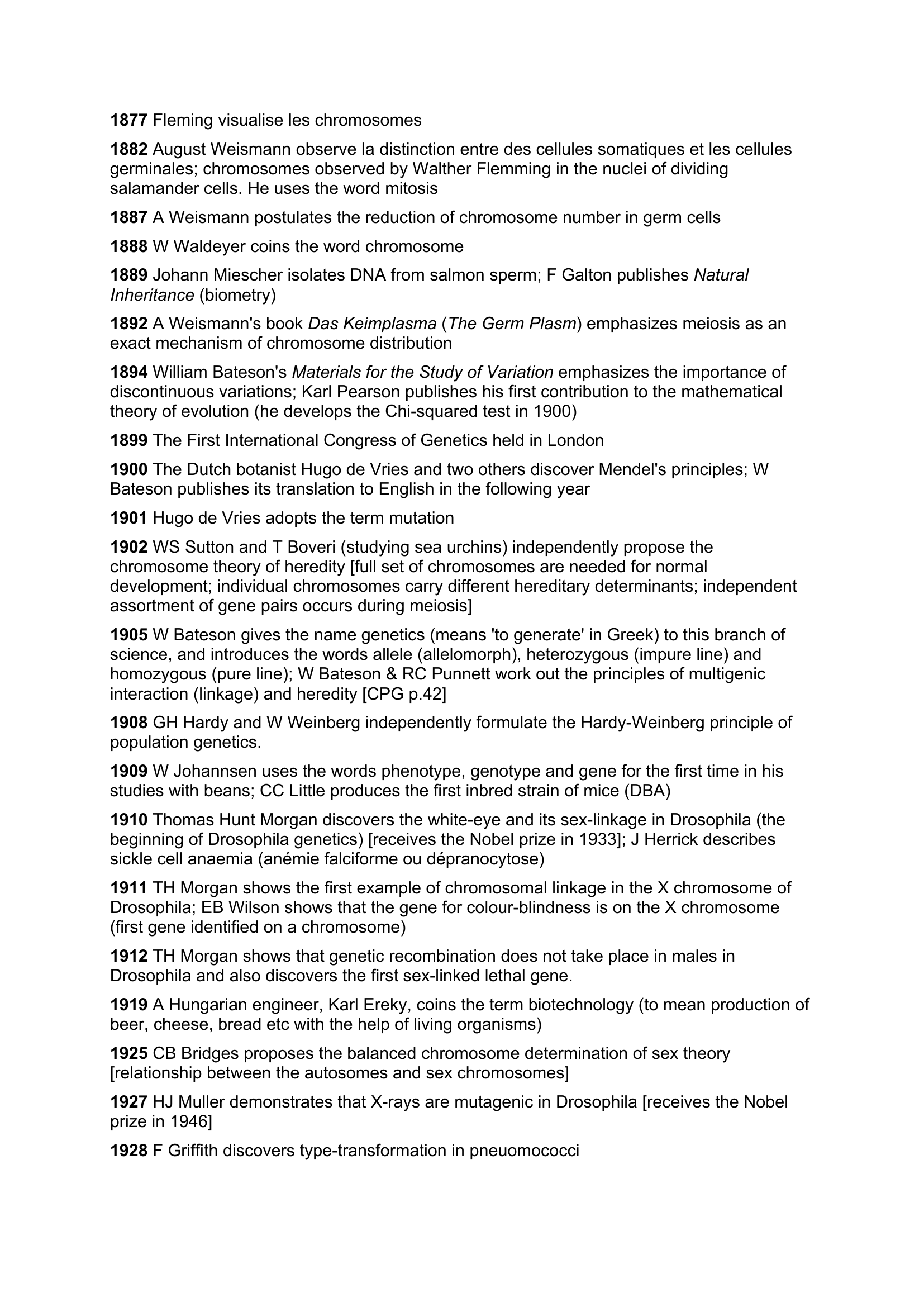Les principales dates de l'Histoire de la Génétique 1651 William Harvey suggère que les individus vivants proviennent tous des ovules.
Publié le 26/02/2014

Extrait du document


«
1877 Fleming visualise les chromosomes
1882 August Weismann observe la distinction entre des cellules somatiques et\
les cellules
germinales; chromosomes observed by Walther Flemming in the nuclei of di\
viding
salamander cells.
He uses the word mitosis
1887 A Weismann postulates the reduction of chromosome number in germ cells
1888 W Waldeyer coins the word chromosome
1889 Johann Miescher isolates DNA from salmon sperm; F Galton publishes Natural
Inheritance (biometry)
1892 A Weismann's book Das Keimplasma (The Germ Plasm) emphasizes meiosis as an
exact mechanism of chromosome distribution
1894 William Bateson's Materials for the Study of Variation emphasizes the importance of
discontinuous variations; Karl Pearson publishes his first contribution to the mathematical
theory of evolution (he develops the Chi-squared test in 1900)
1899 The First International Congress of Genetics held in London
1900 The Dutch botanist Hugo de Vries and two others discover Mendel's princ\
iples; W
Bateson publishes its translation to English in the following year
1901 Hugo de Vries adopts the term mutation
1902 WS Sutton and T Boveri (studying sea urchins) independently propose the
chromosome theory of heredity [full set of chromosomes are needed for no\
rmal
development; individual chromosomes carry di fferent hereditary determinants; independent
assortment of gene pairs occurs during meiosis]
1905 W Bateson gives the name genetics (means 'to generate' in Greek) to this branch of
science, and introduces the words allele (allelomorph), heterozygous (impure line) and
homozygous (pure line); W Bateson & RC Punne tt work out the principles of multigenic
interaction (linkage) and heredity [CPG p.42]
1908 GH Hardy and W Weinberg independently form ulate the Hardy-Weinberg principle of
population genetics.
1909 W Johannsen uses the words phenotype, genotype and gene for the first time in his
studies with beans; CC Little produces the first inbred strain of mice (DBA)
1910 Thomas Hunt Morgan discovers the whit e-eye and its sex-linkage in Drosophila (the
beginning of Drosophila genetics) [receives the Nobel prize in 1933]; J Herrick describes
sickle cell anaemia (anémie falciforme ou dépranocytose)
1911 TH Morgan shows the first example of chromosomal linkage in the X chrom\
osome of
Drosophila; EB Wilson shows that the gene for colour-blindness is on the X chromosome
(first gene identified on a chromosome)
1912 TH Morgan shows that genetic recombination does not take place in males\
in
Drosophila and also discovers t he first sex-linked lethal gene.
1919 A Hungarian engineer, Karl Ereky, coins the term biotechnology (to mean production of
beer, cheese, bread etc with the help of living organisms)
1925 CB Bridges proposes the balanced chromosome determination of sex theory\
[relationship between the autosomes and sex chromosomes]
1927 HJ Muller demonstrates that X-rays are mutagenic in Drosophila [receives the Nobel
prize in 1946]
1928 F Griffith discovers type-transformation in pneuomococci.
»
↓↓↓ APERÇU DU DOCUMENT ↓↓↓
Liens utiles
- Les principales dates de l'Histoire de la Génétique
- THEME 1 : La Terre, la vie et l’organisation du vivant Partie A : Génétique et évolution Chapitre 1 : L’origine du génotype des individus
- HISTOIRE DE WILLIAM LOVELL (résumé)
- HISTOIRE DE LA CONQUÊTE DU MEXIQUE (L’) William Hickling Prescott (résumé)
- HISTOIRE D’HENRY ESMOND (L’) (résumé) William Makepeace Thackeray (résumé)










